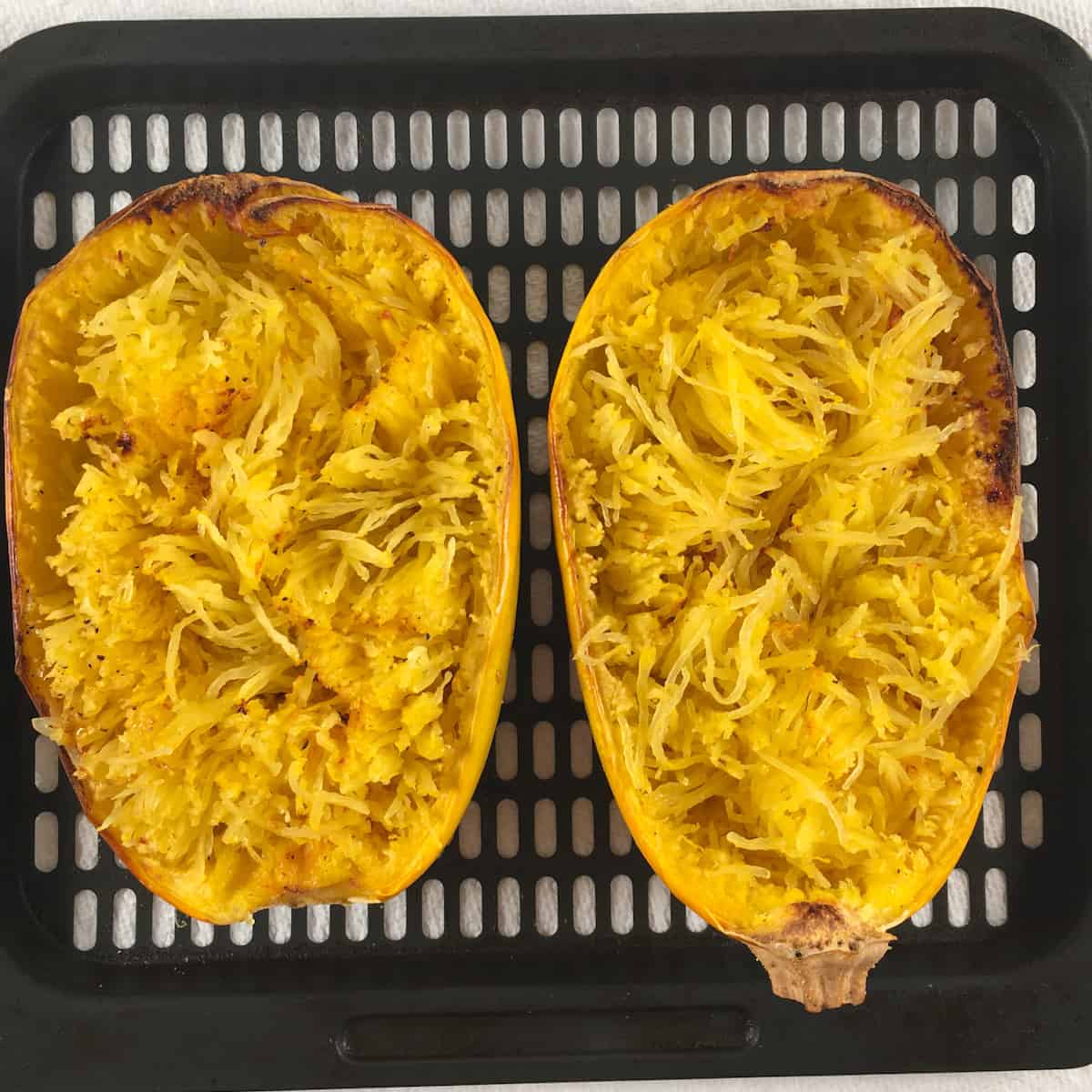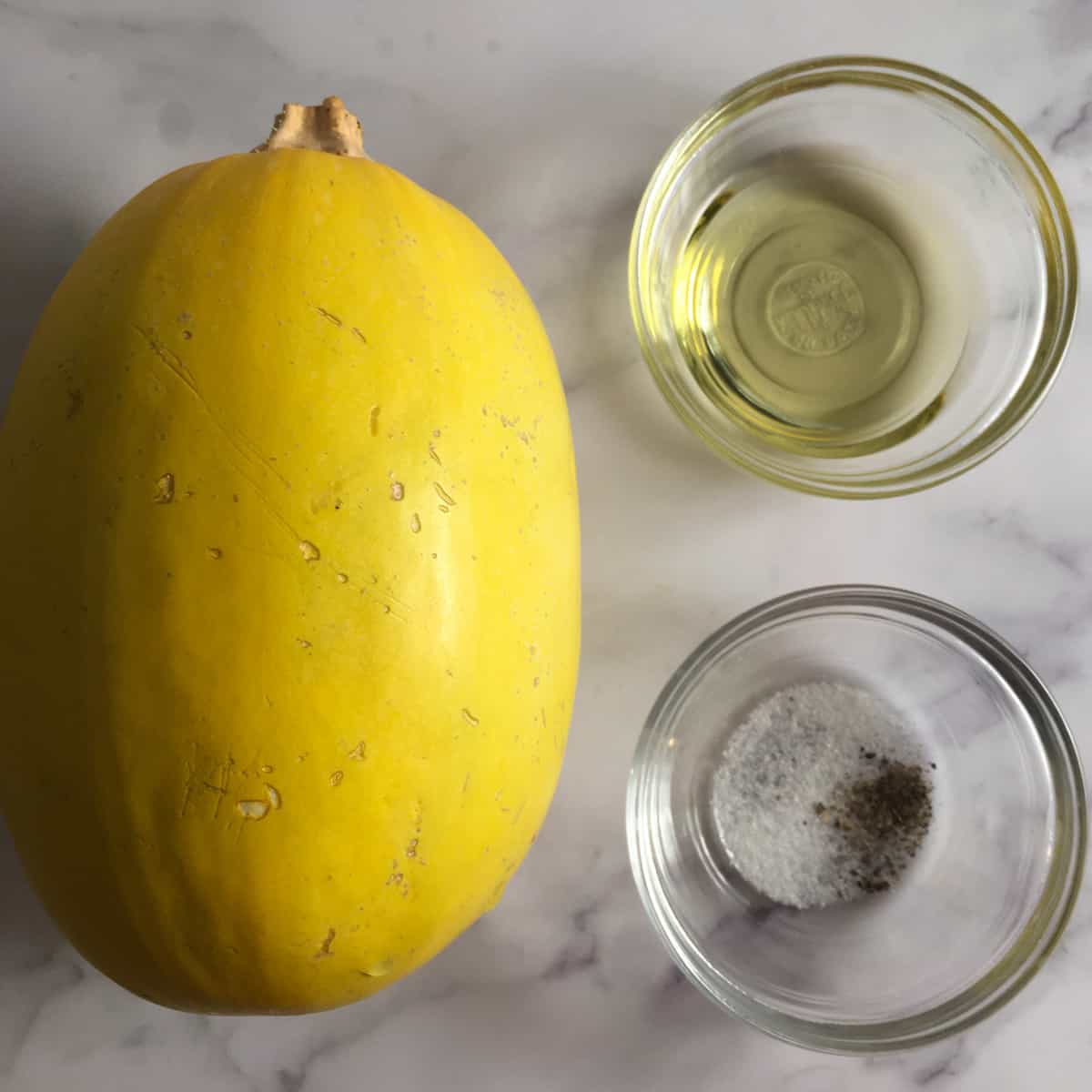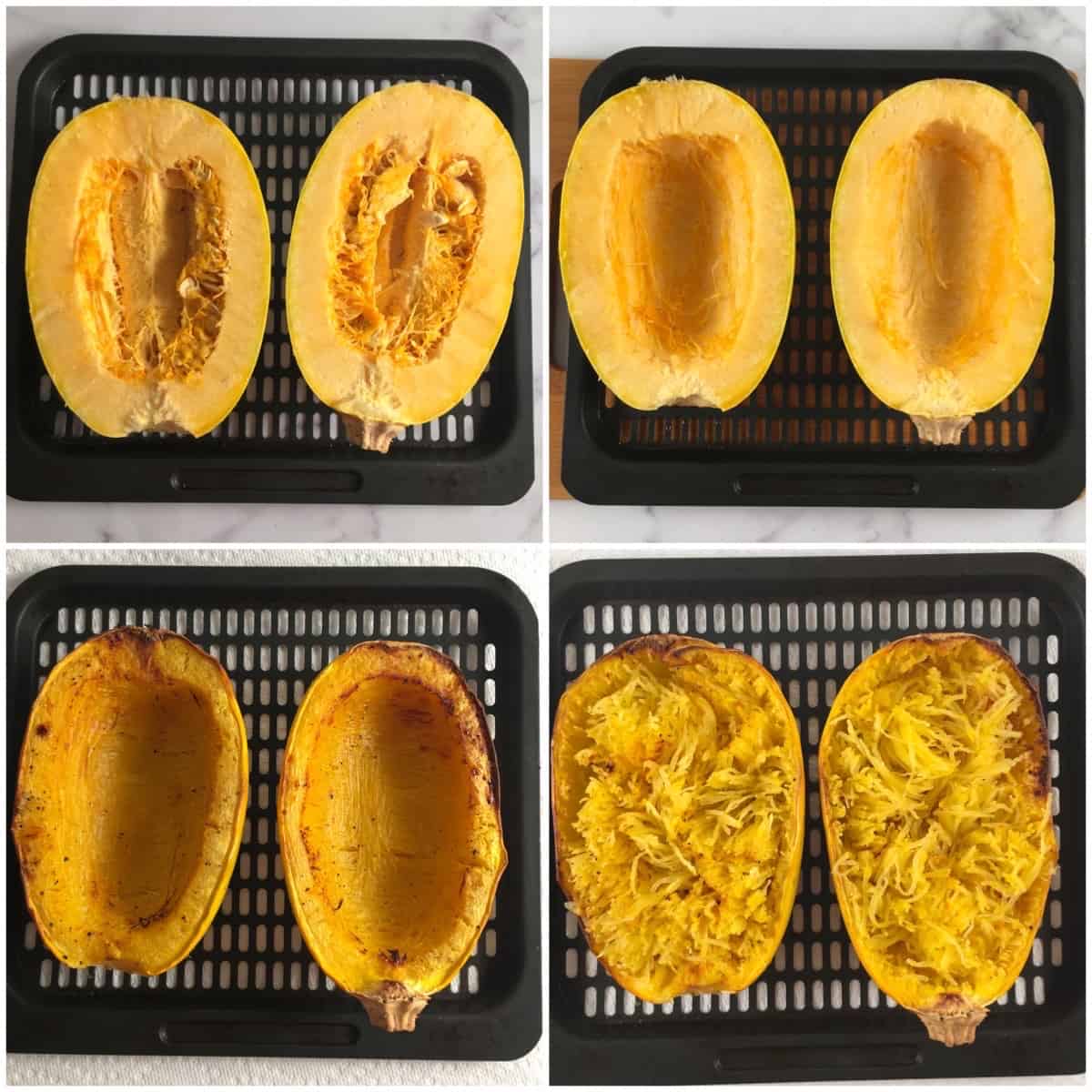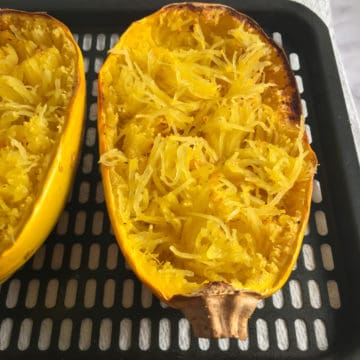What temperature to air fry spaghetti squash? Spaghetti squash in air fryer takes 25 minutes at 375F (190C). This air fryer time and temp is how to get spaghetti squash to be more like al dente pasta and less mushy. You’ll love this winter squash recipe as an easy low carb, low calorie, gluten free, vegan, whole30, and keto pasta alternative.

Want to save this post?
Enter your email below and we'll send it straight to your inbox. Plus you'll get great new recipes from us every week!
What’s your favorite winter squash? I think the most delicious winter squash is delicata squash. If I have to choose a squash for versatility, my vote goes to spaghetti squash.
Cooked spaghetti squash flesh separates easily into strands a little thicker than angel hair pasta. It’s perfect with pasta sauce, and in hash browns or fritters. Though it makes a delicious side dish, we can also serve it front and center as a pasta substitute.
You can oven bake, microwave, or make air fried spaghetti squash. This spaghetti squash air fryer recipe is the best spaghetti squash recipe around, IMVHO.
Cooking spaghetti squash in the air fryer is fast and easy, making eating healthy meals more convenient. I’m going to give you the air fryer spaghetti squash temperature and air fryer time for perfect results every time. But first, let’s cover some basics!
Table of Contents
- ❓ How to pick spaghetti squash?
- ✂️ How to Cut a Spaghetti Squash
- ⭐ Benefits of Making Spaghetti Squash in Air Fryer
- 🥘 Air Fryer Spaghetti Squash Ingredients
- 🔪 How to Air Fry Spaghetti Squash
- ️⏲️ What temperature to air fry spaghetti squash?
- 🌡️ Leftovers
- 🥗 How to Serve Spaghetti Squash
- 📋 Calories, Net Carbs, Protein
- FAQs
- 🥦 More Easy Air Fryer Vegetable Recipes
- 👩🏻🍳 Other Spaghetti Squash Recipes
- 📖 Recipe Card
- What Temperature to Air Fry Spaghetti Squash? (Air Fryer)
- 💭 Expert Tips from Dietitian Summer Yule
- 💬 Comments
❓ How to pick spaghetti squash?
Since we’re air frying spaghetti squash, the most important thing is to get a squash that fits in your air fryer. You probably don’t want the biggest spaghetti squash you can find at the farmer’s market or supermarket.
How do you know when spaghetti squash has gone bad?
Check your squash to make sure it has no cracks, soft spots, black discoloration, or mold. Ripe spaghetti squash should be bright yellow in color and firm to the touch.
How to store uncooked spaghetti squash?
You can store whole (uncut) spaghetti squash in a cool, dry place for 2-4 months. Cut spaghetti squash should be stored in the fridge an airtight container or Ziplock bag for 3-4 days.
Can spaghetti squash be eaten raw?
Technically, you can eat spaghetti squash raw. In terms of taste, I do not recommend it.
✂️ How to Cut a Spaghetti Squash
Is there an easy way to cut open a spaghetti squash? If you've never prepared a spaghetti squash before, it might feel a little intimidating. No worries though, cutting a squash is easy.
Winter squashes are often dirty on the outside. We don't want the dirt to get inside the squash when we cut it.
So first, scrub any dirt off the spaghetti squash and rinse with cool water. Pat the squash dry with a paper towel or a clean kitchen towel. Using a sharp knife, cut the stem end off the squash if it is long. (I typically leave it.)
Cut the squash lengthwise (i.e., the long way), from the stem to the blossom end. The inside of the uncooked spaghetti squash will not look stringy- that is normal!
Scoop the seeds out of the spaghetti squash halves and set them aside. I like using an ice cream scoop to remove the seeds, but a regular spoon works too.
We're only using the fleshy strands of the spaghetti squash in this air fryer recipe, but please do not discard the seeds! Spaghetti squash seeds can be roasted in the oven just as you'd roast pumpkin seeds. You essentially get a free bonus snack each time you purchase a fresh spaghetti squash.
⭐ Benefits of Making Spaghetti Squash in Air Fryer
Why should you make spaghetti squash in the air fryer? Here's some of the (many!) reasons you’ll love this recipe:
- Quick and cheap gluten free pasta: There's some excellent whole food gluten-free pastas available (like this one), but they can be expensive. One large spaghetti squash makes enough "pasta" for 2-4 people and will cost much less when purchased in season.
- Healthy Veggie: Most Americans are not meeting the recommendations in the Dietary Guidelines for vegetables. This spaghetti squash helps to increase your vegetable intake.
- Helps you eat less white flour: Sometimes when we add something to our meals, another food gets pushed out. Using spaghetti squash may help you eat less white flour pasta. This is a good thing for many Americans since most of us exceed the recommended limits for refined grains.
- Special diet friendly: These cooked spaghetti squash strands are low carb, low calorie, vegan, whole30, Paleo... just about everyone can enjoy!
- (Almost) Hands-Off Cooking: Air frying leaves you free to tend to other parts of the meal. After cutting the spaghetti squash, this recipe is pretty much hands off!
- The Best Way to Cook Spaghetti Squash: If you want mush-free spaghetti squash strands, this air fryer squash recipe is where it is at. I love how the edges get slightly caramelized as it cooks; it adds even more flavor to this versatile veggie.
🥘 Air Fryer Spaghetti Squash Ingredients
You need very little for the basic air fry spaghetti squash recipe. Here's the roundup:
- Fresh, whole spaghetti squash
- Avocado oil
- Salt and pepper

Another oil can be used in place of avocado oil, like olive oil or canola oil. (That said, I prefer this flavorless oil for cooking at higher temperatures.)
You can make air fryer spaghetti squash without oil by simply skipping the oil. The squash turns out drier, but it can still work.
How to season spaghetti squash?
This is a basic air fryer spaghetti squash recipe that uses salt and black pepper. Here are some more ideas for seasoning spaghetti squash:
- Everything but the bagel seasoning
- Cajun spice
- Old Bay seasoning
- Shredded Parmesan cheese
- Italian seasoning (basil, parsley, oregano, etc.)
- Cinnamon (and brown sugar or maple syrup for those with a sweet tooth)
🍽 Equipment
Here’s the kitchen equipment needed for spaghetti squash in an air fryer:
- Knife
- Ice Cream Scoop
- Pastry Brush
- Air Fryer
What air fryer to use for spaghetti squash? An air fryer oven is best for this recipe. A small air fryer basket may not fit a spaghetti squash half.
Cooking times may vary between the Ninja Foodi, Kalorik, Philips, Nuwave, Pampered Chef, Actifry, Instant Pot Vortex, Cosori, Breville, and other air fryer brands. It's a great idea to check the food early the first time you try a new air fryer recipe!
🔪 How to Air Fry Spaghetti Squash

After you’ve cut the squash into halves and scooped out the seeds, you can air fry it. Brush the cut side of each spaghetti squash half with oil and sprinkle with salt and pepper.
You may be able to fit one spaghetti squash half or two in the air fryer at a time. This depends on the size of your squash, and the size of your air fryer. Put the squash on a rack in the middle of the air fryer oven (cut sides up).
️⏲️ What temperature to air fry spaghetti squash?
How long to air fry spaghetti squash? What temperature to air fry spaghetti squash? Cook spaghetti squash for a total of 25 minutes at 375 degrees Fahrenheit (190C).
After the cooking time is up, remove the squash from the air fryer. After the squash has cooled a bit, you can remove the squash strands from the squash skin with a fork.
How to cook whole spaghetti squash in the air fryer?
Scrub dirt from squash, rinse with cool water, and pat dry. Poke through the spaghetti squash skin all over with a sharp knife. Air fry at 400F (200C) for 35-40 minutes in the middle of the air fryer oven. After cooking, you can slice and remove the seeds. The squash strands will have more moisture than air fried spaghetti squash halves.
How do you know if spaghetti squash is done?
The spaghetti-like strands should scrape out easily when the squash is adequately cooked. If you press into the sides of the squash, they should have some give, no longer very firm.

🌡️ Leftovers
How long is spaghetti squash good after it’s cooked? Leftover spaghetti squash strands can be stored in a covered container in the fridge for 3-4 days. You can save half a spaghetti squash by wrapping in plastic wrap before refrigerating.
Can you freeze spaghetti squash? Any cooked squash that won’t be used in 3-4 days should be frozen. Store it in a plastic freezer bag with the air pressed out. Defrosted squash tends to be a bit more watery, so use a dry heat cooking method to reheat.
How to reheat spaghetti squash in air fryer? You can reheat leftover refrigerated spaghetti squash in an air fryer set to 350F (177C) for 2-4 minutes. Alternatively, you can reheat leftover spaghetti squash for 1-2 minutes in the microwave.
🥗 How to Serve Spaghetti Squash
What goes with spaghetti squash? I love tomato sauce and other types of spaghetti sauce with spaghetti squash. Here are some other ideas for spaghetti squash sauces:
- Air Fryer Spaghetti Bolognese
- Keto Cheese Sauce
- Alfredo Sauce
- Carrot Leaves Pesto
- The Sauce in Are Carrots Fruits or Vegetables?
And here are some proteins that go with spaghetti squash:
📋 Calories, Net Carbs, Protein
One generous serving of air fryer spaghetti squash has 141 calories, 15.3 grams net carbs, and 2.1 grams protein. This nutrition information is an overestimate that doesn’t account for the weight of the parts not eaten (squash skin). Spaghetti squash is a low carb food (and higher carb squashes can be considered “good carbs”).
FAQs
Can you eat the entire spaghetti squash?
Aside from the stem, the entire air fried spaghetti squash is edible. However, I don't recommend eating the skin of the spaghetti squash because it tends to be tough. (FYI, other squash skins that I DO NOT recommend eating include pumpkin, acorn squash, and large butternut squashes.)
What happens if you overcook spaghetti squash?
With many recipes, spaghetti squash will become watery and mushy if you overcook it. In this air fryer spaghetti squash recipe, the squash will blacken, burn, and dry out too much if it’s overcooked.
How to microwave spaghetti squash?
Clean the whole, uncut squash and jab it all over with a sharp knife. Place it in a microwave safe bowl and microwave on high for 6 minutes. Check the squash for tenderness. If it is still firm, microwave for up to 6 minutes more. Total cooking time depends on the size of the squash.
Can you make air fryer frozen spaghetti squash?
Yes, you can make frozen spaghetti squash in the air fryer. Stir some oil into the frozen spaghetti squash strands and air fry for 15-20 minutes in an air fryer oven at 400F (200C). Stir the squash and switch the racks in the oven halfway through cooking time. Exact cooking time will depend on amount of squash being cooked.
How to make Instant Pot Spaghetti Squash?
Cut the spaghetti squash in half and remove the seeds. Put a metal Instant Pot trivet in the bottom of the Instant Pot. Add 2-3 cups of water (keep the water level below top of trivet). Place squash on trivet and pressure cook on high for 8 minutes. Quick release the pressure.
🥦 More Easy Air Fryer Vegetable Recipes
Have you checked out these other air fryer recipes for vegetables yet?
👩🏻🍳 Other Spaghetti Squash Recipes
I love recipes using spaghetti squash! Here are a few more ideas for what to make with spaghetti squash:
- Ground Chicken Air Fryer Recipe (for spaghetti squash boats)
- Keto Cincinnati Chili
- Air Fryer Sausage and Peppers (Serve it over spaghetti squash instead of in a hoagie roll for a low carb meal!)
📖 Recipe Card
Watch How to Make It!

What Temperature to Air Fry Spaghetti Squash? (Air Fryer)
Ingredients
- 1 small spaghetti squash (approximately 1 lbs, 5 ounces/0.6 kg)
- 1 tablespoon avocado oil
- salt and pepper, to taste
Instructions
- Rinse the spaghetti squash with cool water and dry with paper towels or a clean kitchen towel.
- Cut the squash lengthwise and scoop out the seeds. I use an ice cream scoop to remove the seeds, but a regular spoon will do.
- Brush each squash half with ½ tablespoon of oil and sprinkle with salt and pepper.
- Place the squash halves, cut side up, on a rack in the middle of the air fryer oven. (If you use a large squash, you may have to cook one half at a time.)
- Air fry the squash for 25 minutes at 375°F (190°C).
- After the cooking time is up, remove the squash from the air fryer. Let the squash cool a bit, then remove the squash strands from the squash skin with a fork. The spaghetti-like strands should scrape out easily when the squash is adequately cooked.
Notes
💭 Expert Tips from Dietitian Summer Yule
This is a level 1 recipe (may help support fat loss). Is air fryer spaghetti squash healthy? Using spaghetti squash instead of a flour-based pasta is a nutritious way to create a high-volume meal for few calories. Wondering why? A typical 2-ounce serving size (dry) of flour-based pasta is 180-210 calories. This includes both grain and legume-based pastas. This is actually a very small serving size of pasta; most of us have several servings of pasta in a sitting. Think about it. When you purchase a standard 16-ounce package of dry pasta, how likely is it that you'll split it into 8 servings? We typically split a one-pound box of pasta into 3-4 servings in my household. That means we're getting 400-500 calories of pasta per serving (or more, in some cases). In this recipe, we're using one spaghetti squash for two large servings. The spaghetti squash plus the small amount of oil used for air frying provides approximately 140 calories per serving. That means I have lowered the calories in my meal by 250-350 calories with this simple swap. Consistently making (relatively) small changes like this in your diet may have a big impact over time. It's an easy way to improve your diet quality if you tend to eat too many refined grains and not enough vegetables. Plus, you don't have to track anything (macros or calories) to get the benefits of swapping out spaghetti for spaghetti squash. I suspect that this sort of simplicity is part of the appeal of low carb diets for some people. Swapping out grain foods for lower calorie (but high volume) foods may help support weight loss – no math required! Nutrition information is for one serving of the recipe. This is likely an overestimate as weight of the parts not eaten (squash skin) haven’t been excluded.
nutrition info disclaimer
All recipes on this website may or may not be appropriate for you, depending on your medical needs and personal preferences. Consult with a registered dietitian or your physician if you need help determining the dietary pattern that may be best for you.
The nutrition information is an estimate provided as a courtesy. It will differ depending on the specific brands and ingredients that you use. Calorie information on food labels may be inaccurate, so please don't sweat the numbers too much.
"To taste" means to your preferences, which may have to be visual to follow food safety rules. Please don't eat undercooked food x
Nutrition
Join our community! Subscribe for all of the latest and greatest recipes, and follow me on Facebook, Pinterest, Instagram, and YouTube!

Hello! I'm Summer, a registered dietitian and home chef who loves to cook, eat, and create high quality content for you! Every recipe on this site has been tested by me to help ensure your success in the kitchen. All eaters are welcome here 🙂



Jeanmarie Frede says
I agree with you